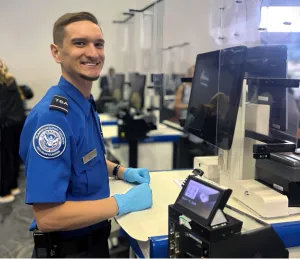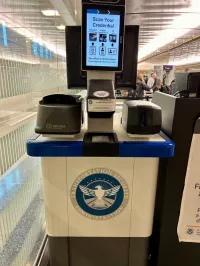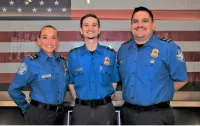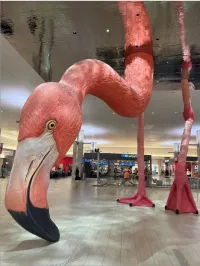
One evening at Tampa International Airport, a female passenger handed a Florida driver's license to Transportation Security Officer Justin Causby who was at the travel document checker station. The woman was very quiet during her screening and refused to look at Causby or into the camera.
Causby joined TSA just two years ago, but his experience and training told him something wasn’t quite right.
When the Credential Authentication Technology 2 (CAT-2) machine displayed a non-match status, Causby thought the traveler might not understand the process.
Credential Authentication Technology 2 machine (TSA photo)
“I explained that I would need to retake her picture from a different angle,” said Causby. “I adjusted the CAT-2 machine's height higher and advised her to look directly into the camera.”
The woman continued to look down for the second CAT-2 photo, prompting the machine to return another non-match.
Lowering the CAT-2 this time, Causby again told the passenger he needed to take another photo and advised her to look directly into the camera. As before, the woman continued to avoid looking directly into the camera.
Receiving a third biometrics non-match, Causby’s “Spidey sense” was on fire.
“Once I was given the third biometrics non-match status, I proceeded to take a closer look at the photo on the ID and the person standing in front of me,” recalled Causby.
Crediting TSA’s sophisticated training, a keen eye to detail and critical thinking skills, Causby was able to determine that the individual standing in front of him was not the person in the photo ID she presented.
Causby asked the traveler to step to the side as he radioed for a supervisor. He continued processing other passengers waiting in line while keeping an eye on the woman.
“It was at that point when the individual tried to step closer to me, possibly to try and get past the travel document checker queue,” Causby said. “I quickly blocked her path, again advised her to step to the side and pointed to where she needed to wait, and said a supervisor would be with her shortly.”
Lead TSA Officer Anthony Sosa responded and asked Causby to scan the ID in the CAT-2 a fourth time. Not only did the machine return a fourth biometrics non-match, but Sosaagreed with Causby that there was a mismatch.
Supervisory TSA Officer Tonia Wolfson was the first supervisor to arrive, and Sosa and Causby explained the situation. Wolfson then approached the woman to gather more information. As Wolfson went to the podium at the back of the checkpoint, carrying the passenger’s presented ID, Causby observed the woman heading toward the shuttle to the main terminal.
Causby immediately asked Wolfson to hurry back to his station, as it appeared the woman was attempting to leave the checkpoint. Wolfson brought the traveler back to the checkpoint before she was able to make good on her escape.
After further investigation by airport police, with Wolfson’s help, the woman finally admitted she purposefully used her friend's name and ID to try to evade outstanding warrants for her arrest and to circumvent security.
“Although the CAT-2 is a great tool to assist us with the screening process, it is important to remember the screening equipment is exactly that – a tool for assistance,” Causby reminds us. “During the screening process, it is still ultimately up to us as the frontline officers to make sure we are staying vigilant at all times, continuing to think critically and engaging our network, to ensure proper screening is conducted so we can successfully carry out the TSA mission.”
“We are so excited to recognize Justin for the good catch,” Supervisory TSA Officer Connie Mota said. “I think this is a great opportunity to highlight the incredible work our officers do daily. While there is no denying the CAT technology is an impressive decision support tool, without the critical thinking, attention to detail, investigative work and the team effort displayed by the officers on Airside A, this catch wouldn’t have occurred.”
By Michele Robbins, TSA Strategic Communications & Public Affairs



